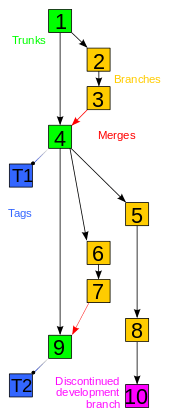Commit (version control)
In version control systems, a commit adds the latest changes to [part of] the source code to the repository, making these changes part of the head revision of the repository. Unlike commits in data management, commits in version control systems are kept in the repository indefinitely. Thus, when other users do an update or a checkout from the repository, they will receive the latest committed version, unless they specify they wish to retrieve a previous version of the source code in the repository. Version control systems allow rolling back to previous versions easily. In this context, a commit within a version control system is protected as it is easily rolled back, even after the commit has been applied.
Usage
Git
To commit a change in git, in Terminal (OS X) or command line (assuming git is installed), the following command is run:
git commit -m 'commit message'
This is also assuming that the files within the current directory have been staged as such:
git add .
The above command adds all of the files in the working directory to be staged for the git commit. After the commit has been applied, the last step is to push the commit to the given software repository, in the case below named origin, to the branch master:
git push origin master
